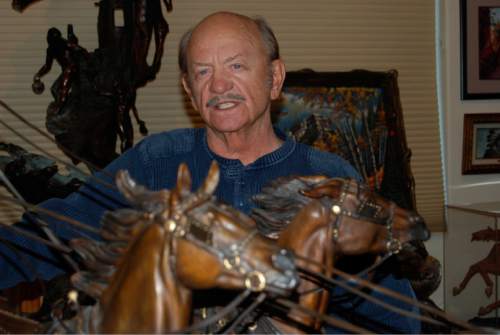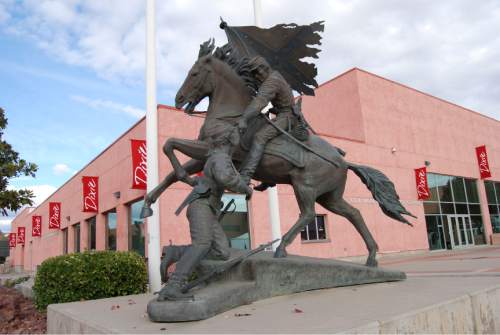This is an archived article that was published on sltrib.com in 2015, and information in the article may be outdated. It is provided only for personal research purposes and may not be reprinted.
A statue of Confederate soldier boys is gone once and for all from Dixie State University — a move by the school to shed lingering ties to slavery.
In an agreement with Leeds artist Jerry Anderson, the school has traded in "The Rebels." A replacement sculpture of bronze horses by Anderson is set to go up sometime this year.
"What it means is that we can officially put the Confederate identity behind us," said university spokesman Steve Johnson, who called the statue the last campus 'emblem' of the school's Confederate ties. "Now the university can move forward."
The school put the statue in storage in December 2012 as Dixie State worked to win university status and still maintain "Dixie" in its name. The statue had become a flash point and staging area for anti-racism rallies. Lawmakers granted the university status in 2013.
"I think it was a bunch of 'balarney'," he said Tuesday, referring to the statue's removal from campus. "But it had to happen."
The 80-year-old artist said he recognizes why some officials wanted to uproot the statue but added, "I think America is too politically correct."
Shortly before the artwork was removed from campus, someone threw a sheet over its Confederate flag.
"The statue has become a lighting rod. We feel bad about that," then-Dixie State President Stephen Nadauld said at the time. "It's a beautiful piece of art. We are nervous something might happen to the statue. It might be vandalized."
St. George's nickname as Utah's "Dixie" has sparked sensitivity and debate, with younger generations noting the South's shameful history of slavery. Others have argued the moniker is harmless shorthand for the area's warmer climes and Mormon pioneers' attempts to grow cotton in the region.
For a time, Dixie State University administrators fully endorsed the connection to the antebellum South.
Inspired by the song "Two Little Boys," which tells the story of two young men who reunite as Union soldiers during the Civil War, Anderson depicted the soldiers in a small sculpture called "Retreat" 30 years ago. In 1983, he was commissioned to create a life-sized version.
"I want people to know that the statue really didn't represent one nation," Anderson said in an interview Tuesday. "It represented every war in every country. What they've forgotten to see in that message is two boys helping each other."
The statue was installed first at the Green Valley Mall and later donated to the Dixie Convention Center on the university campus in 1987. Anderson sold the statue to the school for $35,000 in the 1980s.
"We are very appreciative of Mr. Anderson's generous artistic contributions, not only to Dixie State University, but to the entire region," DSU President Richard B. Williams said in a statement. "We are grateful to Jerry for working with us and we look forward to displaying his work on this campus for everyone to view and enjoy in the years to come."
After the school removed "The Rebels," a judge declared the university its legal owner.
"You've got to make everybody happy, is what I've learned from it all," Anderson said.
The statue is back at his studio and is set to be installed in a Leeds gallery. The artist invited the public to come look at it any time.
"Art shouldn't be hidden," he said. "Art is created for history. Not for what's right and what's wrong, but for everyone to be able to see and learn from."





